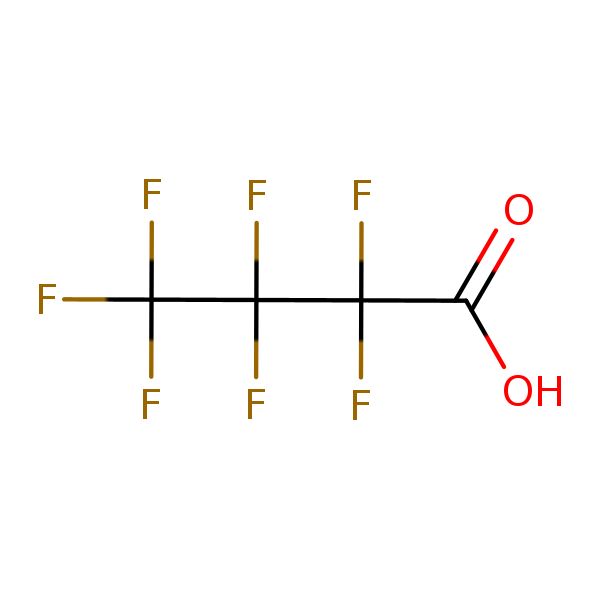Perfluorobutanoic Acid (PFBA)
CASRN 375-22-4 | DTXSID4059916
IRIS Toxicological Review of Perfluorobutanoic Acid (PFBA) and Related Salts (Public Comment and External Review Draft, 2021)
On this page:
Alert
Notice
UPDATE: In June 2022, EPA released the final peer review report they received from ERG (a contractor to EPA) from the peer review they hosted on the review of the IRIS assessment of Perfluorobutanoic Acid (PFBA) and Related Salts. This meeting was held February 22-23, 2022.
Overview
The updated IRIS Toxicological Review of Perfluorobutanoic Acid (PFBA) and Related Salts draft was re-released for public comment and external peer review in October 2021. The IRIS assessment of PFBA will undergo an independent external scientific peer review managed by Eastern Research Group, Inc. (ERG), a contractor to EPA. Additional information about the peer review will be posted on the IRIS website. Additionally, the same peer review panel will conduct all five (5) PFAS IRIS assessments.Background
Perfluorobutanoic Acid (PFBA, CASRN 375-224) and its related salt (ammonium perfluorobutanoic acid [NH4+PFBA], CASRN 10495-86-0) are members of the group of per and polyfluoroalkyl substances (PFAS). Concerns about PFBA and other PFAS stem from the resistance of these compounds to hydrolysis, photolysis, and biodegradation, which leads to their persistence in the environment. PFAS are not naturally occurring in the environment; they are man-made compounds that have been used widely over the past several decades in consumer products and industrial applications because of their resistance to heat, oil, stains, grease, and water.PFBA is a breakdown product of other PFAS that are used in stain-resistant fabrics, paper food packaging, and carpets; it is also used for manufacturing photographic film, and it is used as a substitute for longer chain perfluoroalkyl carboxylic acids (PFCAs) in consumer products. PFBA has been found to accumulate in agricultural crops and has been detected in household dust, soils, food products, and surface, ground, and drinking water.
As such, exposure is possible via inhalation of indoor or outdoor air, ingestion of drinking water and food, and dermal contact with PFBA-containing products.
| Date | Description |
|---|---|
| Nov 2019 | EPA released the Systematic Review Protocol for the PFAS IRIS Assessments (Preliminary Assessment Materials). [Federal Register Notice Nov 8, 2019] |
| Jul 2020 | EPA released an update to the Systematic Review Protocol for the PFBA, PFHxA, PFHxS, PFNA, and PFDA IRIS Assessments in response to public comments. |
| Aug 2020 | EPA sent an interagency science consultation PFBA draft for review and comment. |
| Aug 2021 | EPA released the draft IRIS Toxicological Review of Perfluorobutanoic Acid (PFBA) and Related Compound Ammonium Perfluorobutanoic Acid for a 60-day public comment period and external peer review. Additionally, EPA announced the solicitation for the nominations of members to a PFAS IRIS Review Panel that will review all five assessments. [Federal Register Notice Aug 23, 2021] |
| Oct 2021 | EPA extended the public comment period until November 8, 2021. EPA additionally updated the draft and supplemental information documents and included an erratum to clarify that the assessment addresses the PFBA free acid as well as simple salts of PFBA. [Federal Register Notice Oct 20, 2021] |
| Feb 2022 | ERG, a contractor to EPA, hosted an independent public peer review meeting from February 22-23, 2022, to discuss the review of the IRIS assessment of PFBA and related salts. |
| Jun 2022 | ERG, a contractor to EPA, submitted their final peer review report to EPA on the review of the IRIS assessment of PFBA and related salts (see downloads). |
Status
The Perfluorobutanoic Acid (PFBA) IRIS assessment was released for a 60-day public comment period. Following the external peer review meeting, the assessment will be revised taking into consideration all public and external peer review comments received.Download(s)
This download(s) is distributed solely for the purpose of pre-dissemination peer review under applicable information quality guidelines. It has not been formally disseminated by EPA. It does not represent and should not be construed to represent any Agency determination or policy.
- IRIS Toxicological Review of Perfluorobutanoic Acid (PFBA) and Related Salts (Public Comment and External Review Draft, Oct 2021) (PDF) (129 pp, 2.8 MB, about PDF)
- IRIS Toxicological Review of Perfluorobutanoic Acid (PFBA) and Related Salts - Supplemental Information (Public Comment and External Review Draft, Oct 2021) (PDF) (90 pp, 1.5 MB, about PDF)
- PFBA Errata Sheet (PDF) (1 pp, 117.2 KB, about PDF)
- PFBA Draft Charge to External Peer Reviewers (Public Comment and External Review Draft) (PDF) (6 pp, 202.1 KB, about PDF)
- External Panel Peer Review of EPA's Draft "IRIS Toxicological Review of Perfluorobutanoic Acid (PFBA) and Related Salts" Final Peer Review Report (PDF) (107 pp, 1.0 MB, about PDF)
If you have a disability and the format of any material on our web pages interferes with your ability to access the information, please reach out to us using the Contact Us about IRIS form for assistance. To enable us to respond in a manner most helpful to you, please indicate the nature of the accessibility problem, the web address of the requested material, your preferred format in which you want to receive the material (electronic format (ASCII, etc.), standard print, large print, etc.), and your contact information.
Document Related Link(s)
- IRIS Toxicological Review of Perfluorobutanoic Acid (PFBA) and Related Compound Ammonium Perfluorobutanoic Acid (Public Comment and External Review Draft, Aug 2021) (PDF) (130 pp, 2.9 MB, about PDF)
- IRIS Toxicological Review of Perfluorobutanoic Acid (PFBA) and Related Compound Ammonium Perfluorobutanoic Acid - Supplemental Information (Public Comment and External Review Draft, Aug 2021) (PDF) (91 pp, 1.5 MB, about PDF)
- Systematic Review Protocol for the PFAS IRIS Assessments (2021)
- Toxicological Review of Perfluorobutanoic Acid and Related Compound Ammonium Perfluorobutanoic Acid (PFBA) (Interagency Science Consultation Draft, 2020)
- External Peer Review Activities for PFBA Integrated Risk Information System (IRIS) Assessment (Nov 2021)
Federal Register Notices
Docket
Comments on the assessment may be submitted and reviewed using the Docket ID EPA-HQ-ORD-2020-0675Related Links
Critical Effect Systems
Chemical Structure for
Perfluorobutanoic Acid (PFBA)




